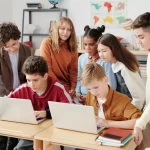In a quiet corner of a bustling school hallway, there’s a classroom that looks a little different. The chairs are arranged with extra space in between. Visual cues are posted at every turn. There’s a sensory area in the back with soft lights, calming music, and tactile toys. For many students, this room is more than a place of learning it’s a sanctuary tailored to their individual needs. This is a special education classroom, where every learner is given a chance to thrive.
What Is a Special Education Classroom?
A special education classroom is a learning environment designed specifically for students with disabilities or special needs. These classrooms provide personalized instruction, modified curriculum, and specialized support services that help students reach their full potential. They are often staffed with trained special education teachers, aides, and therapists who collaborate to meet each child’s Individualized Education Program (IEP) goals.
Key Features of a Special Education Classroom
To be effective, a special education classroom must be thoughtfully designed. It should balance structure and flexibility while promoting both academic growth and social development.
1. Individualized Instruction
Students in these classrooms often learn at different paces and through various methods. Teachers tailor lessons to fit individual learning styles and needs, whether through visual aids, hands-on activities, or assistive technology.
2. Low Student-to-Teacher Ratio
A lower ratio allows educators to provide more one-on-one time with each student, which is critical for addressing behavioral and academic challenges.
3. Inclusive and Safe Environment
A special education classroom fosters a sense of belonging. It ensures that students feel safe, respected, and supported emotionally and physically.
4. Use of Assistive Technology
From speech-to-text software to communication devices for non-verbal students, technology plays a key role in breaking down barriers to learning.
5. Behavior Support Systems
Many classrooms implement behavior management plans or use positive reinforcement strategies to support emotional regulation and classroom harmony.
The Role of Educators in a Special Education Classroom
The success of a special education classroom heavily depends on its educators. Their responsibilities go far beyond traditional teaching roles.
Teachers as Advocates
Special education teachers often serve as advocates for their students. They work closely with parents, general education teachers, and administrators to ensure that student needs are met and rights are protected.
Collaborating with Support Staff
Speech therapists, occupational therapists, and behavioral specialists are integral members of the support team. Together, they help create a holistic educational experience.
Professional Development
Given the evolving nature of special education laws and techniques, educators must continually engage in training to stay updated and provide the best care possible.
Inclusion vs. Self-Contained Classrooms
There’s often debate about whether students with disabilities should be taught in general education classrooms or special education classrooms. The answer is not one-size-fits-all.
Inclusive Classrooms
Inclusion involves teaching students with disabilities alongside their typically developing peers. This approach promotes social interaction and reduces stigma. However, it requires significant support, including co-teaching models and classroom aides.
Self-Contained Special Education Classrooms
These are separate classrooms where students receive individualized attention. While they can offer a focused environment, critics argue that they may isolate students from the broader school community. The best settings are often those that blend both models based on each student’s IEP.
Benefits of a Well-Structured Special Education Classroom
A well-run special education classroom provides numerous benefits not just for students, but for educators and families as well.
Academic Progress
Students are more likely to make academic gains when instruction is personalized and expectations are realistic yet challenging.
Improved Behavior
Structured routines and behavior support plans can lead to significant improvements in classroom behavior and self-regulation.
Increased Confidence and Independence
As students succeed in small, meaningful ways, they build confidence and develop the skills necessary for greater independence.
Challenges Faced in Special Education Classrooms
Despite the progress made in inclusive education, special education classrooms still face significant challenges.
Lack of Resources
Many schools struggle to provide adequate funding for staff, training, and materials. This can limit the quality of education offered.
High Teacher Burnout
Special education teachers often face emotional exhaustion due to the intensity of their work. According to the National Coalition on Personnel Shortages in Special Education and Related Services, 49 states reported shortages of special education teachers as of 2023.
Stigma and Misunderstanding
Unfortunately, there is still a lack of understanding about disabilities and the purpose of special education classrooms, leading to social stigmatization and isolation of students.
Creating a Positive Learning Environment
Creating an effective special education classroom goes beyond curriculum and staffing. The environment itself plays a key role in student success.
Sensory-Friendly Setup
Noise-dampening panels, soft lighting, and sensory stations help students manage overstimulation and stay focused.
Clear Visual Cues and Schedules
Visual schedules, labels, and signs help non-verbal or neurodivergent students navigate their day with ease.
Flexible Seating and Movement
Options like standing desks, wobble chairs, and floor cushions allow students to move while learning, aiding in concentration and comfort.
Collaboration Between Parents and Teachers
Parents are essential partners in a child’s education. Communication and collaboration between families and educators strengthen the effectiveness of any special education classroom.
Regular Updates and Meetings
Frequent communication through notes, emails, or apps helps keep parents informed of their child’s progress and needs.
Parental Involvement in IEPs
Parents are critical members of the IEP team and should be actively involved in setting and reviewing educational goals.
Home Reinforcement
Skills learned in the classroom are best reinforced at home. Parents can support learning by practicing routines, social skills, and self-help techniques with their children.
The Future of Special Education Classrooms
The landscape of special education is continually evolving, influenced by research, advocacy, and technology.
Universal Design for Learning (UDL)
UDL is a framework that aims to make learning accessible for all students. It encourages flexible teaching methods and materials that can be adjusted to suit individual needs.
Virtual and Hybrid Learning Options
Post-pandemic education models now include virtual learning for students with medical or behavioral needs that make in-person learning difficult.
Policy and Funding Reforms
Improved funding, teacher training, and national awareness campaigns are essential to strengthening the infrastructure of special education across the globe.
Summary Table: Key Elements of a Special Education Classroom
| Feature | Description |
|---|---|
| Individualized Instruction | Tailored teaching methods based on student IEPs |
| Low Student-to-Teacher Ratio | More personalized attention and support |
| Assistive Technology | Tools like communication apps and adaptive software |
| Behavior Support Plans | Structured approaches to managing behavior |
| Inclusive Environment | Safe and supportive space for all learners |
Conclusion
A special education classroom is more than just a separate room it’s a lifeline for many students who need extra support to thrive academically, socially, and emotionally. With the right resources, training, and collaboration, these classrooms can transform the lives of students and families alike. As we look toward the future, how can we ensure that every student regardless of ability has access to the education they deserve?





